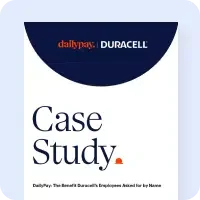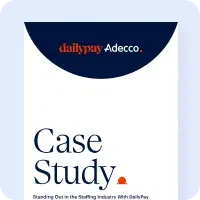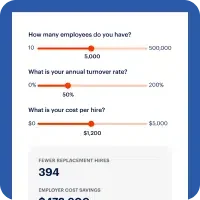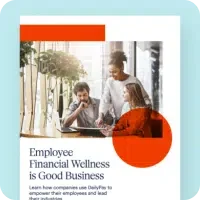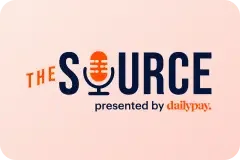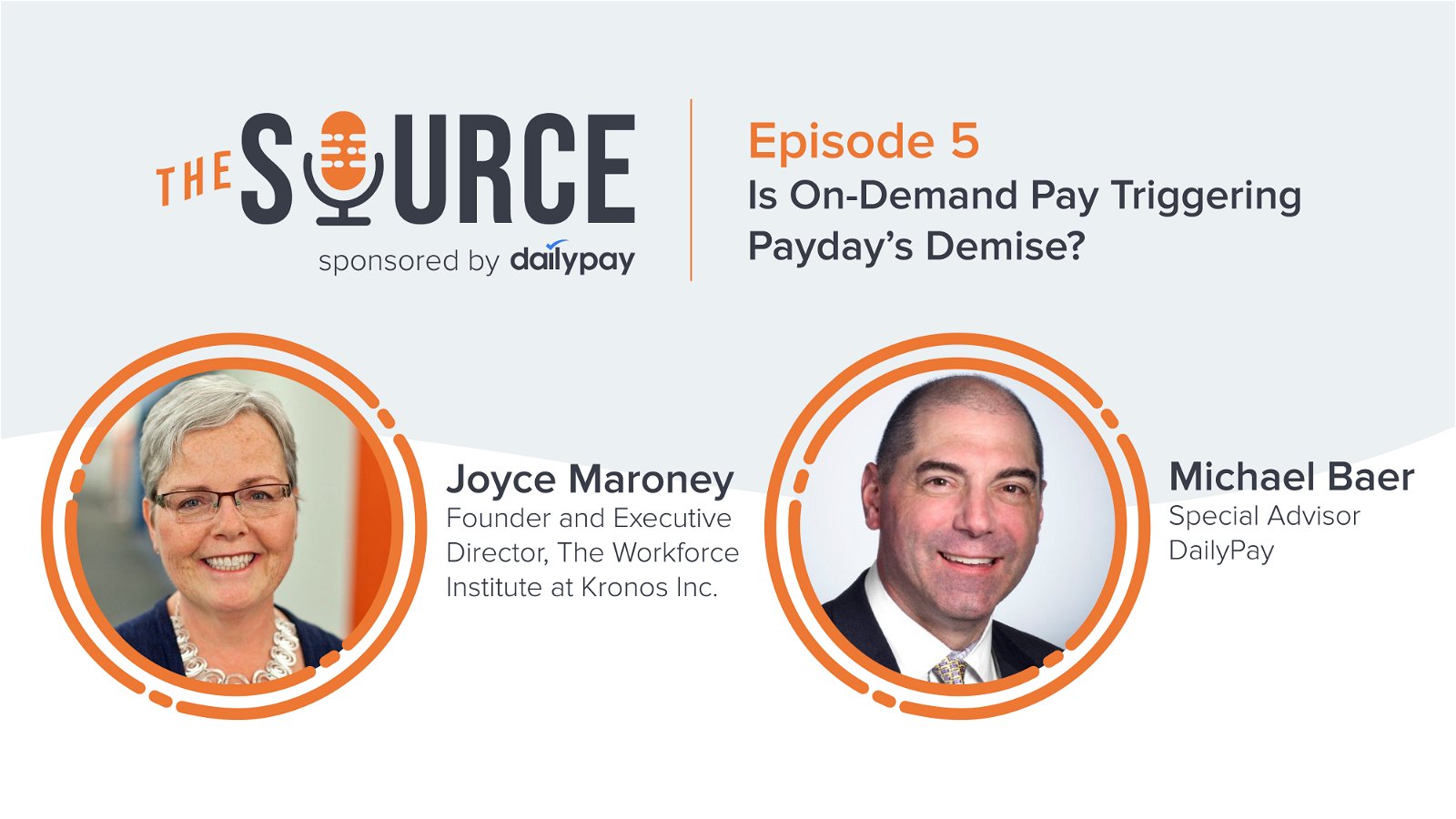Episode Description: First, it was employers who wanted to implement a practical, low-cost Dailypay benefit to reduce turnover and attract workers. Now, nearly three-fourths of respondents in a recent Harris survey say they desire access to their pay when earned, and there is a future not void of paydays, but full of them. Join Michael Baer of DailyPay and his special guest, Joyce Maroney, Executive Director of the Kronos Workforce Institute, as they discuss the late 2019 survey they commissioned, the results and what they mean for paying workers now and into the future.
About Our Speakers

Joyce Maroney is the founder and executive director of The Workforce Institute at Kronos Incorporated. In addition to her executive director duties, she blogs at www.workforceinstitute.org and, as a spokesperson for Kronos, has been quoted frequently in the media on a variety of topics impacting the workforce. She has published four anthologies on workforce development and management. Prior to joining Kronos, Maroney served as a vice president at BrassRing and has held front line and management positions in marketing, sales, and operations for large technology firms.
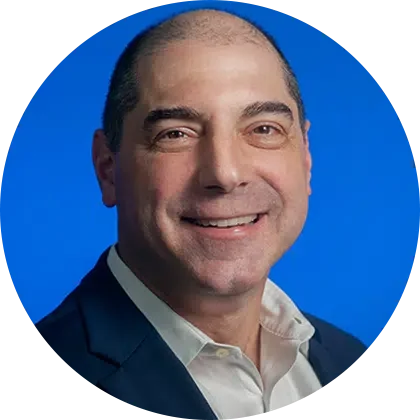
Michael Baer is the host and executive producer of The Source podcast. Michael previously oversaw domestic and international payroll news and analysis at Bloomberg Tax, previously BNA.
In a career spanning three decades, Michael transformed the role of managing editor, becoming an information services leader who managed every aspect of world-class global products and platforms, while continuously increasing revenue and achieving market-best customer satisfaction. He directed a team of editors and writers who were charged with translating complicated tax and labor laws into English so non-lawyers could easily understand and apply them, and was integral in organizing and placing that content on easy-to-access web platforms, resulting in the highest net promoter scores the company had seen for any of their offerings.
Michael has been a frequent public speaker for conferences and webinars, and now is the host of The Source, sponsored by DailyPay. Michael joined the DailyPay team in 2019.
In this podcast you will learn about…
- Why the Harris poll is significant for employers and their employees
- Features of on-demand pay that surveyed employees like best
Thanks for tuning in!
Podcast Transcript:
Speaker 1:
Welcome to The Source, your monthly resource for regulatory updates and issues in the on demand pay industry. The Source is brought to you by DailyPay, the industry leading provider of the DailyPay benefit. This material is for general information only and the views expressed herein reflect only the views of DailyPay. This program should be considered marketing material and should not be relied on for legal, tax, accounting or regulatory advice. And now let’s welcome our host
Michael Baer:
Hello everyone and welcome to The Source. The Source is sponsored by DailyPay and it’s your look into active and upcoming legislation, industry insights and news, and a chance to understand the complexities and questions surrounding issues in the early access to pay industry. Today, we’re going to dive into first, some new developments since most state legislators started meeting in January, then we’ll move on to our featured content, which is the latest Harris Poll commissioned by Workforce Institute at Kronos in late 2019. It covers on demand pay, and I am happy we have with us Joyce Maroney, the executive director of the Workforce Institute, who wrote recently about the death of the paycheck. So we can discuss these findings. Joyce, welcome,
Joyce Maroney:
Thanks so much for having me, Michael.
Michael Baer:
All right. I’m looking forward to it. First as is traditional for us at The Source, we like to make a shout out to impactful legal events that happened on this day, February 12th. And a lot has happened on this date. One thing that happened is Abraham Lincoln was born in 1809 on February 12th, and president Lincoln he freed the slaves in 1863. It is Black History Month so this is very appropriate. And 100 years after that, marking Lincoln’s 100th birthday on February 12th, 1909, that was the founding of the NAACP, the National Association for the Advancement of Colored People.
Michael Baer:
On kind of a different twist, a different note, 21 years ago on February 12, 1999, president Clinton was acquitted by the senate on two articles of impeachment after a five week trial, kind of ironic considering today’s events or the events in the recent past here with president Trump. Well Joyce, first I’m going to give us some news in the DailyPay arena, and then we will get to that featured topic today. Your article on the death of the paycheck, based on the survey your team conducted, with The Harris Poll covering on demand pay.
Michael Baer:
Leading off the news, I want to say a coalition of 21 state attorney general bipartisan have voiced their objection in a comment letter to the office of the comptroller of the currency, urging the OCC to pull back on a proposed rule that the attorney general said would enable predatory payday lenders to circumvent state interest rate caps through a “rent a bank scheme”. What is a rent a bank scheme, you may ask? It is a way predatory payday lenders can avoid state usury or interest limits on short term payday-like loans by using regulated national banks as lenders in name only and enter into what the state attorney general said were, “Sham partnerships with unregulated entities that they can receive exemptions that allow them to issue loans at interest rates that exceed state caps.” Pressure on the OCC has been coming from various sources to rescind the proposal, but it remains to be seen what comes out of this protest. Comments on the proposal were due January 21st.
Michael Baer:
Also many state legislatures have convened for their 2020 sessions. In 16 of them, there’s at least one piece of legislation introduced that will modify in some way, mostly to limit interest rates for primarily predatory payday lending issues. So the states that have introduced legislation so far include … and I’m going to read the list and you can go back and relisten to this podcast if you want to hear the full list again. The states are Delaware, Hawaii, Illinois, Indiana, Maine, Michigan, Missouri, Nebraska, New Jersey, New Mexico, New York, Rhode Island, South Carolina, Tennessee, Virginia, and Wisconsin.
Michael Baer:
Now these mostly have just been introduced or are in their early committee stages of approval, but we at DailyPay are keeping an eye on all of them. Back to federal issues. Bills introduced earlier this session in the Congress that would limit to 36% the interest on loans countrywide to all consumers, not just those in the military, have gone nowhere since being introduced in November. But that doesn’t mean these initiatives are dead as Congress has been making other issues a priority since late November, if you know what I mean. Many of the state pieces of legislation mentioned earlier are similarly setting a 36% interest cap on loans but with that loophole I was talking about developed to do an end around state usury limits through the rent a bank method, unless the limit is made federally, the sky can be the limit for resourceful predatory loan operators.
Michael Baer:
The payday loan operator drama will continue as they seek to maintain operations in this new year. Payday lenders say they cannot absorb interest rates as low as 36% and still stay in business, partly because the default rate is just so high. So stay tuned next month for another timely update from DailyPay on all the new developments in our space.
Michael Baer:
On that note, let’s move on to this important survey conducted last fall. Joyce, the finding seemed to confirm that employed American adults want access to pay before payday in almost overwhelming numbers. However, as we discussed some before this podcast, are we really looking truly at like the death of a paycheck? Because it kind of seemed to me that what we are seeing is a future not really void of paydays, but full of them as people will have daily access to pay. I’m thinking you all meant the death of a paycheck in a different light. Could you explain a little bit about that?
Joyce Maroney:
Sure. I think that’s a fair way to reframe our findings. Our key takeaways are that the majority of our respondents said they wanted on demand access to their earnings and that the traditional fixed pay day may no longer work for everybody.
Michael Baer:
Okay. That’s great. We see that that traditional fixed pay day, the end of that, it’s coming like a train. What compelled the Workforce Institute to commission the survey in the first place? What were you all seeing out there that you felt this was warranted?
Joyce Maroney:
Well, let me start by explaining a little bit about the Workforce Institute at Kronos. we are part of Kronos Incorporated. We’re a world leader in providing workforce management and human capital technology to organizations around the world. We founded the Workforce Institute back in 2006, 2007, in order to provide folks with workplace insights that can help them drive performance by addressing human capital management issues that affect both hourly and salaried employees.
Joyce Maroney:
And when we started, there really wasn’t much best practice advice out there for people whose employees were mostly paid hourly. One of the ways that we get these insights, especially for these jobs that require presence, is we conduct surveys throughout the year. We’ll generally do about half a dozen surveys a year to dig into some of these very particular issues. In this case, a number of our Kronos customers, especially in the retail space, have asked us to help them explore how they might offer on demand pay to their employees and especially retail, lots of young employees who are working gig jobs elsewhere, who are working in other kinds of mechanisms where they are getting more on demand pay.
Joyce Maroney:
And from a technology perspective, Kronos are linked into their systems in a way that we would be the system of record for timekeeping for these customers. So this is the thing we’re exploring from a think tank perspective through research, but also through a technology perspective, through partnerships with organizations like DailyPay. In the survey, we also asked about financial wellness in terms of what are people looking for from their employers when it comes to financial wellness as a benefit? And I think we’re talking about that a little later in this interview.
Michael Baer:
Well, thank you very much, and full disclosure here. I need to add for the audience that as a young payroll clerk, I was part of the team adopting a brand new automated time-keeping product offered by a startup called Kronos. So that’s how far I go back, Joyce. Your organization has really grown and spread its wings and DailyPay is proud to be part of the Kronos workforce dimensions technology partner network. Now moving on here, can you tell us a bit specifically about The Harris Poll that was commissioned by your group and what were you looking to understand?
Joyce Maroney:
In this particular survey, and I should clarify this as a US only survey, we wanted to understand the attitudes of workers about how they were paid and how their employers could improve that experience. We had 1,180 employed adults participate in this commissioned Harris Poll back in October of 2019. And one of our top findings is that 70% of our respondents said they wished they had access to their earned wages before their scheduled payday, at least some of the time. So this wasn’t 72% said a 100% of the time, but 72% said that circumstances definitely arose in their lives that would lead them to want access to their earned income before they’re paid.
Michael Baer:
Wow. And that’s kind of the big takeaway, so that nearly three quarters of the respondents wish they had access to their earned pay before payday at some point.
Joyce Maroney:
Yes.
Michael Baer:
But there are a bunch of other key figures that shout out to me from this survey report, you all have put out from the Workforce Institute. For example, while nearly three quarters of these respondents wish they had access to earned pay before payday, only 6% polled had actually access to that DailyPay benefit or on demand pay. This means this large demand is currently not being met by employers. Can you elaborate on this? And there are some other interesting breakdowns as well without going into too much detail, of course.
Joyce Maroney:
Yeah, sure. One of the interesting things that we heard from these folks was that 51% believe that on demand pay is a more attractive benefit than additional paid time off, which we thought was pretty interesting given how attractive a benefit paid time off is. The other thing that was really interesting was that it’s not just lower wage workers who are looking for faster access to their money. We did find that nine out of 10 of those making less than 50,000 a year annually in their household wished they could get on demand pay. But we also saw that more than two thirds of those with household income of 50,000 or more would like that access as well.
Michael Baer:
I saw that in those reports that you had, the two big takeaways I see there for employers are that the daily benefit, is favored … maybe just slightly favored, but still favored over more paid time off by these respondents. And paid time off from a payroll perspective, at least is a huge burden to administer and from the overall employer perspective is much more costly. The second takeaway there is the likely adoption by those making 50,000 more a year. That I think shows the desire is strong among higher income workers to have access to earned amounts before payday. And that this benefit, just like you said, is not just for the lower wage staff, cash flow problems seem to occur at all levels is what I’m seeing here.
Joyce Maroney:
Yeah, absolutely. I mean, we also saw that more frequent pay periods would be welcomed. So these folks, 24% are currently paid weekly, but 42% wish they were. So that certainly points to a desire for again, more frequent access to their wages. We also saw some pretty mind boggling responses with regard to what fees people would be willing to pay for early access to their earnings. About 75% of hourly and 71% of the salaried workers in this survey said they’d consider paying up to a $5 fee to access $50 of their wages before payday. Nearly one in 10, 8% in the survey would consider a $50 fee reasonable to access $50 of their earned wages early.
Joyce Maroney:
So, I mean, that one really jumped out at me. It could signal some real desperation among people for safe and reliable access to their own money as an alternative to short term payday loans. I’m not sure how many of those actually would charge you a 100% of the amount you were borrowing, but that’s what some of these folks in this survey were willing to pay.
Michael Baer:
Well, these payday loan operations can end up charging up past 500% on the annual percentage interest rate. So yes, people pay a lot more for the money upfront than the money they actually are getting. And wow Joyce, all I can say is that it seems like the providers of on demand pay might get that idea that they can charge employees more for this access. And employees, maybe like you were mentioning, they’re so desperate to get out of a high interest payday loan-like situation that they think a $50 fee is reasonable?
Michael Baer:
To me this kind of shows here how some living paycheck to paycheck, so to speak, have been conditioned maybe to expect such a fee for getting their own earnings. I can tell you it’s good that DailyPay, speaking for us, has very reasonable ATM-like fees. There are no more than $2.99 for instant access to amounts and that’s it. Getting back to the survey, what are some of the socioeconomic factors do you think have led to these results?
Joyce Maroney:
Well, I think most of us are experiencing a macro economy that is booming and we’ve got record low unemployment in the US since going back to the 60s, but yet plenty of people are still struggling to pay their bills. Plenty of people are still underemployed. So they’ve got a job, but maybe not earning at the level that they would expect, based on their skills and education. A Federal Reserve study in 2018 indicated that 53% of Americans say financial stress distracts them at work. And that same study from the Fed Reserve revealed that 39% would be challenged to deal with an unexpected $400 expense. And 25% had skipped medical care that they needed because they couldn’t afford to pay for it.
Michael Baer:
So an on demand pay could be part of the solution to filling that gap, at least mid cycle, if something should happen like that. What I’ve seen here, what we’re noticing here at DailyPay is that employees are embracing the ability to see what they have been earning through the pay cycle. They’re able to do it through our app, regardless of whether they want to take a draw prior to payday. And that knowledge I feel is power.
Michael Baer:
It’s difficult to manually figure your net pay on the fly, but now people can get a good idea of what they have earned simply by accessing the app. In addition, employers are noticing fewer missed punches on the time clock. Again, because I think people want to have a good ongoing record of what they are earning as they go, even if they do not want or need to draw anything. Tell us about other employee experiences and how employers can offer some solutions to help lead employees to financial wellness.
Joyce Maroney:
Sure. Well, we did ask questions about this in the survey, and we found that 74% of people say they’d prefer to work for an employer that offers financial planning, budgeting, and automated savings tools over one that does not. And that included, our biggest cohort was 88% of 35 to 44 year olds. Again, this makes sense given the Federal Reserve data that we already mentioned, that 53% of people experience stress at work due to their financial circumstances.
Michael Baer:
So some sort of … and we’re seeing more employers offering these kind of things through, and part of the solution to this pay experiences is an on demand pay feature. I know the survey does not specifically address this, but in your role, I’m sure you’re seeing concerns and issues employers are having in implementing on demand pay solutions. So what are some of the factors out there that you think could hold back some employers from adopting on demand pay?
Joyce Maroney:
Well, I would say first and foremost, having worked in the tech industry for almost 40 years, many, many people are reluctant to deploy new systems if they feel like they have something that’s already working for them. And payroll being one of the most important processes in an organization is particularly significant to employee experience. We did different research in 2017 about employee’s experience with payroll and we found that more than half of US workers had experienced a problem with their paycheck during their career. 56% reported paying a bill late because of a paycheck error, 58% reported living paycheck to paycheck and having absolutely no patience for employers who couldn’t pay them accurately and on time.
Joyce Maroney:
And in fact, 24% said they’ve looked for a new job after experiencing a single paycheck error while 25% said that they’d be out looking for a new job after two payroll errors. So payroll professionals take their jobs very seriously and the integrity of their systems very seriously, because you’ve got this huge employee experience part of it, you’ve also got very significant compliance issues around payroll as well.
Michael Baer:
Absolutely and I think what I’m hearing here is, especially in this environment of near full employment, the inability of some in some industries to attract the kind of workers that they need, this I think is a compelling reason for employers to actually offer these kind of systems out there. As long as, again, you’re not needing a new payroll system.
Michael Baer:
Fortunately DailyPay doesn’t require a new system. We just require an interface with your existing system so that’s a good thing. The payroll is processed as normal. But you’re right. It’s important that employers get that pay experience right. And coming from a payroll background, I can attest to the pressure and the ramifications of not issuing pay timely or correctly. It is a mess to clean up and it does affect the worker psyche and their confidence in the whole system.
Joyce Maroney:
I mean, that’s why those who are responsible for payroll operations are very reluctant to mess with a solution that is already working for their employees. Payroll is a delicate balance of process, technology, compliance concerns and employee expectations. So to make changes to that delicately calibrated system, I think vendors like ourselves, partners like ourselves, we need to be particularly sensitive to finding ways and implementing our systems in ways that do not disrupt their operations while we’re doing so.
Michael Baer:
Yes. And as I mentioned, our partners with DailyPay, they run payroll as if they don’t offer a DailyPay benefit. In fact, they likely will not know if an employee has made a draw prior to payday, but that certainly is a factor because there are models out there that do impact more directly the payroll processes and our listeners should be aware of that.
Michael Baer:
Now, you’re probably not into making predictions in your role, but I hearkened back to that 6%. The 6% of those employees survey last October having access to on demand pay, and there’s that huge room for expansion here nearly up to 72% would desire it. Can you comment on what the future appears to be for on demand pay? Maybe not this year, but if you can great. Or at least in the upcoming say five years, do you think most employees will have access to on demand pay by 2025, Joyce?
Joyce Maroney:
Well, I think that in general, in a supply side labor market, like the one that we have now, employers are looking hard for things that will give them an edge with respect to employee experience. I think this will definitely nudge some organizations to look more seriously at on demand pay as a kind of solution that is going to provide that employee experience edge.
Joyce Maroney:
And again, I think the inhibitor to on demand pay adoption, like most significant systems changes in organization, is the fear of breaking not only that core process that you’re upgrading, but breaking processes that might be integrated to it. I think the key is that organizations need to think hard about what is the pain of not changing if their competitors are able to offer financial benefits, like early access to earned wages and they are not? They may find that pain of not having that system eventually becomes bigger than whatever change management process they have to go through in order to implement it and be able to offer it to their employees.
Michael Baer:
I think that’s so true, Joyce. And just to bring up some other statistics we’ve had recently is that on the payroll system side, there’s 20% or so of employers consider every year a change in their payroll systems anyway, and that is a dramatic change. I do talk to a lot of folks in the payroll field and a good percentage of them are in the middle of a new upgrade or some sort of a change over in their service provider or their software systems. And all those can introduce those problems that you mentioned but this is a fairly common occurrence on the payroll system side is to have these upgrades. So my sense is that it’s extremely crucial to retain employee satisfaction and retention by making these transitions as smooth as possible.
Michael Baer:
We’ve seen the DailyPay benefit dramatically increase retention. And the return on investment is pretty astronomical. This year I think we’ll see many employers move on to this. Even if that perceived pain you’re talking about of not having the DailyPay benefit is not that great. I have to say, Joyce, I think it just makes sense in this employment market and as demographics have changed and employee expectations have mirrored changes in customer expectations where everything is instant, convenient and experience. I think employers will embrace this as a big part of enhancing their employee experiences. Joyce, do you have any further comments before we close out?
Joyce Maroney:
Well, I would say thank you so much for having me today. If people did find the survey results interesting, there is a lot more workforceinstitute.org and you can subscribe to follow us there so that anytime we publish new research, you’ll be among the first to know about it. So thanks for inviting me on the show. I really appreciate it.
Michael Baer:
Joyce Maroney, the executive director of the Workforce Institute at Kronos, thank you so much for joining me today and sharing your thoughts on this important survey from your Workforce Institute. Listeners, all I can say is, I hope you got a lot out of this podcast. I sure did. This was one key survey and there will be more to come.
Michael Baer:
Now, I want to say, thanks for joining The Source where DailyPay provides information and analysis on the pay experience movement. Stay tuned next month for more news, as we further discussed the DailyPay movement with another compelling guest.
Speaker 1:
Thanks for listening to The Source, brought to you by DailyPay. Join us again next month for up to date insight on the on demand pay industry. Keep your eye on your inbox for more information regarding featured guests and new topics.

